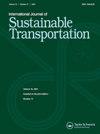Planning for energy-efficient transport in a small town: Influence from different urban configurations of destination points and housing establishments
IF 3.1
3区 工程技术
Q2 ENVIRONMENTAL STUDIES
International Journal of Sustainable Transportation
Pub Date : 2025-02-01
DOI:10.1080/15568318.2024.2448004
引用次数: 0
Abstract
Urban and transport planning can strongly affect energy usage induced by travel in cities. However, most studies investigate large cities with crude measurements of induced travel without consideration of the urban configuration of residences and their trip destinations, and little attention has been paid to smaller cities. We investigate energy usage (CO2-emissions) from car travel in a small Swedish city using a novel approach based on detailed GPS-tracking data of actual car mobility to calculate CO2-emissions on street segments and to identify major destinations. We also construct configuration scenarios, applied to the case city. These scenarios’ induced CO2 emission from transports is evaluated in relation to the current configuration of the city. We find that changes in the urban configuration can impact on energy usage from intra-urban car travel by some 40% compared to the current situation and that the configurations display large relative differences in transport-efficiency, polycentric and public transport-based configurations being more efficient than monocentric development. We conclude that housing allocation is less important for car transport efficiency than re-location of existing destination points. Urban planning needs to be critical to over-simplified densification strategies and analyze the urban configuration to find optimal solutions.
一个小镇的节能交通规划:来自目的地和住房设施不同城市配置的影响
城市和交通规划可以强烈地影响城市旅行引起的能源使用。然而,大多数研究对大城市进行了粗略的诱导旅行测量,而没有考虑居民的城市结构及其旅行目的地,很少关注较小的城市。我们调查了瑞典一个小城市汽车出行的能源使用(二氧化碳排放),使用了一种基于实际汽车移动的详细gps跟踪数据的新方法来计算街道段的二氧化碳排放量并确定主要目的地。我们还构建了应用于案例城市的配置场景。根据城市的当前配置,对这些情景中交通工具引起的二氧化碳排放进行了评估。我们发现,与目前的情况相比,城市配置的变化会对城市内汽车出行的能源使用产生约40%的影响,并且配置在运输效率方面显示出较大的相对差异,多中心和基于公共交通的配置比单中心发展更有效。我们得出结论,住房分配对汽车运输效率的重要性低于现有目的地的重新定位。城市规划需要对过度简化的密度化策略和分析城市配置找到最佳解决方案至关重要。
本文章由计算机程序翻译,如有差异,请以英文原文为准。
求助全文
约1分钟内获得全文
求助全文
来源期刊
CiteScore
8.90
自引率
2.60%
发文量
56
期刊介绍:
The International Journal of Sustainable Transportation provides a discussion forum for the exchange of new and innovative ideas on sustainable transportation research in the context of environmental, economical, social, and engineering aspects, as well as current and future interactions of transportation systems and other urban subsystems. The scope includes the examination of overall sustainability of any transportation system, including its infrastructure, vehicle, operation, and maintenance; the integration of social science disciplines, engineering, and information technology with transportation; the understanding of the comparative aspects of different transportation systems from a global perspective; qualitative and quantitative transportation studies; and case studies, surveys, and expository papers in an international or local context. Equal emphasis is placed on the problems of sustainable transportation that are associated with passenger and freight transportation modes in both industrialized and non-industrialized areas. All submitted manuscripts are subject to initial evaluation by the Editors and, if found suitable for further consideration, to peer review by independent, anonymous expert reviewers. All peer review is single-blind. Submissions are made online via ScholarOne Manuscripts.

 求助内容:
求助内容: 应助结果提醒方式:
应助结果提醒方式:


